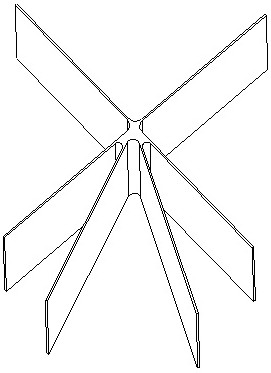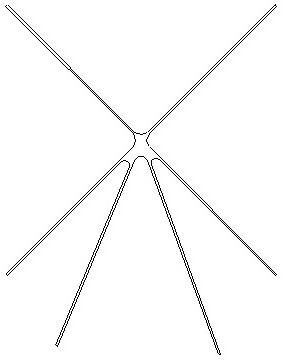A deformation control method for additive manufacturing of thin-walled partition parts
A technology of additive manufacturing and deformation control, applied in additive manufacturing, additive processing, etc., can solve problems such as deformation of thin-walled isolation parts, achieve the effects of improving surface quality, reducing deformation, and increasing bonding strength
- Summary
- Abstract
- Description
- Claims
- Application Information
AI Technical Summary
Problems solved by technology
Method used
Image
Examples
Embodiment 1
[0040] The three-dimensional digital model of the thin-walled partition parts involved in this embodiment is as follows figure 1 As shown, the material is aluminum alloy, and the forming method is SLM additive manufacturing. After analysis, the size of the part is 220×200×80mm, the thickness of the thin-walled partition is 1mm, and the length of the thin-walled partition is about 100mm. It belongs to a V-shaped part. During the forming process of the thin-walled structure, it is easy to deform and the knife gets stuck, which makes it difficult to form the part. .
[0041] Using the deformation control method for additive manufacturing of thin-walled partition parts of the present application, the steps are as follows:
[0042] S1. Determine the placement of the parts, and determine the growth direction of the parts to be parallel to each thin-walled partition. The 2D profile of a single-layer sintered part as figure 2 As shown, there is no constraint on the position of the...
Embodiment 2
[0047] The three-dimensional digital model of the thin-walled partition parts involved in this embodiment is as follows Figure 5 As shown, the material is titanium alloy, and the forming method is SLM additive manufacturing. After analysis, the size of the part is 300×300×50mm, the thickness of the thin-walled blade is 2mm, and the length of the thin-walled blade is about 130mm. It belongs to a V-shaped part. The stress in the forming process of titanium alloy is large, and the thin-walled structure is easy to deform and jam during the forming process. , making the parts difficult to shape.
[0048] Using the deformation control method for additive manufacturing of thin-walled partition parts of the present application, the steps are as follows:
[0049] S1. Determine the placement of the parts, and determine the growth direction of the parts to be parallel to each thin-walled partition. The 2D profile of a single-layer sintered part as Figure 6 As shown, there is no cons...
PUM
 Login to View More
Login to View More Abstract
Description
Claims
Application Information
 Login to View More
Login to View More - R&D
- Intellectual Property
- Life Sciences
- Materials
- Tech Scout
- Unparalleled Data Quality
- Higher Quality Content
- 60% Fewer Hallucinations
Browse by: Latest US Patents, China's latest patents, Technical Efficacy Thesaurus, Application Domain, Technology Topic, Popular Technical Reports.
© 2025 PatSnap. All rights reserved.Legal|Privacy policy|Modern Slavery Act Transparency Statement|Sitemap|About US| Contact US: help@patsnap.com



